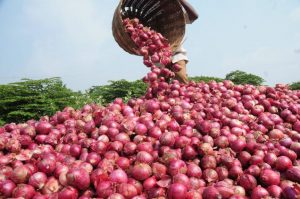Looking for a comprehensive onion farming business plan in Nigeria for your personal use or to seek grants, and loans from investors, CBN, NIRSAL, and other institutions?
To make a successful onion farming business, you must create a solid business plan. This will help you run your farm with proper estimation and identify your strengths and weaknesses. There are different types of onions that you can grow, but spring onions are especially good for human consumption. They grow to a height of about 15 cm and are green when mature. They contain less concentrated flavors than other varieties of onions.

Profitability of onion farming business
The profitability of onion farming business is dependent on many factors. It is possible to sell to a direct market, but this can be risky, as you cannot accurately predict the volume of sales. Generally, you would sell to a grocery store or a supermarket chain, which would command a much higher price for your onion crop. You can also create a niche market by generating real value for consumers.
One of the most important factors in the profitability of onion farming is irrigation. You should water the transplants immediately after planting. Then, irrigate them lightly every seven to ten days, depending on the soil. You can also mulch the soil around the onion plants to retain moisture and prevent weeds from growing. Use organic materials to mulch the area.
Onion production in Nigeria is a lucrative business. While many people think of onions as a menial task for the poor, many families in the north of the country make a lot of money with the crops. These farmers lead comfortable lifestyles. The business is enriching and profitable, so you should consider it if you are interested in agribusiness.
The profitability of onion farming is high, especially if you can grow onions alongside other vegetables. In addition to growing onions, you should also consider other types of crops. They tend to grow well together and can boost your yields. For example, if you grow potatoes and other vegetables along with onions, you will reap an average of about 8 tons of vegetables per acre.
The Onion Farmin business plan will have these chapters:
- Introduction
- Executive summary
- Business Description
- Objective and Goals
- Mission and Vision Statement
- Management
- Material and Equipment
- Competitor analysis
- Market Strategy
- Market trends
- Our target market
- Our competitive advantage
- Sales and marketing strategy
- Sales forecast
- Payment options
- Financial analysis
- Sources of startup capital
Costs of growing onions
There are a few factors to consider when considering the costs of growing onions. First of all, you must decide how you are going to sell the onions. You may either sell them wholesale to retailers or retail to individual consumers. If you choose to sell them to individuals, you may find that the prices you earn are less than wholesale prices.
The costs of growing onions vary based on the farming system you use. Small-scale farming is more affordable, while larger-scale farming requires more capital. The costs also depend on the kind of labour you use. Local labor and free labor are low-cost, while modern technological machinery will require trained personnel and will result in higher salary demands.
Another important factor to consider when estimating the costs of growing onions is the yield. It will affect revenue significantly. Revenue is the total dollar value of sales for a given period minus the total cost. Your budget should account for both direct and indirect sales of onions. Then, you must factor in the risk of price fluctuations.
The average yield per acre depends on a number of factors. Higher yields will require more labor, which will raise variable expense. You must also consider the amount of time required for harvest, drying, and packing. Additionally, box purchases and delivery costs will increase or decrease with the yield. You also need to consider the time it takes to transport the onions to market.
Onions are an expensive crop. The costs of growing them will vary depending on the type of growing method you choose. For example, growing onions from seed can be less expensive than planting them from plugs. But, growing from seed can be very time-consuming. However, if you want to maximize the profit of your harvest, you should consider growing them from bare roots. Using bare roots increases the yield by 35% or more. Onions are more profitable if they have a higher proportion of small and medium-sized bulbs.
Managing weeds on an onion farm
There are several ways of managing weeds on an onion farm, including a crop rotation system and good herbicides. You may also need a hand weeding crew to eliminate weeds that escape cultivation. However, it’s important to know that onion seedlings are highly sensitive to herbicides, which is why it’s best to apply a contact herbicide prior to seedling emergence. This will help manage weeds until the seedlings have two true leaves.
Hand weeding is effective but labor-intensive. Onion plants have tight plant spacing and multiple seed lines within one bed, making it difficult to remove weeds by hand. Also, hand weeding can damage young onions. However, if you’re committed to handweeding, there are several methods to minimize the time spent on handweeding. Use of herbicides or pre-emergence herbicides are other methods to minimize weed growth. Flaming is also an option, but it is more effective in fields that have already been primed with prime seed.
Herbicides are available as both a preplant and postplant application. Herbicides are most effective at controlling emergent and perennial weeds. The choice of herbicide depends on your soil type, weed species and crop rotation. When it comes to applying herbicides, timing is crucial. Herbicide residues can restrict the growth of sensitive rotational crops, such as onions.
Proper irrigation is a must for onions. You can use drip irrigation, which requires less water than conventional methods. But be sure to keep in mind that irrigation systems may require grid hydroelectricity energy. You may also need solar or standby diesel generators to protect your crops during power outages. If you live in an area where electricity isn’t readily available, you may use animal drawn equipment to cultivate the land. A higher level of mechanization will increase the efficiency of operations and increase profitability of your onion farm business.
Growing conditions for growing onions
One of the most important things to consider when growing onions is how to manage water and temperature. Onions are prone to drought stress, and they should be watered regularly. During their growing season, they should be watered to a depth of 12 inches. During dry periods, the roots of the onion will suffer, reducing the yield, size, and flavor. It is also essential to stop watering the crop when the tops begin to fall. Excess watering as the crop matures can delay curing and cause storage problems.
Different types of onions require different growing conditions. In particular, they require different amounts of daylight, so plan accordingly. There are three main types of onions: long-day, intermediate-day, and short-day. Short-day onions need ten to twelve hours of sunlight per day to grow, while long-day varieties need fourteen to 16 hours.
Onion plants grow well in temperatures between 13 and 24 degrees Celsius. However, they do not grow well in extremely hot or cold weather. Ideally, they should grow in moderate temperatures. They are best grown in sunny climates with moderate rainfall. Whether growing in a raised bed or a row, onions require good drainage.
To start a successful onion farming business, you must address water issues. For example, onions should be watered when transplanted, and then lightly watered every three days. You should also make sure to irrigate the soil at intervals of seven to ten days, depending on the soil type and weather conditions. It is also important to mulch the onions so that the soil will retain moisture and prevent weeds. To mulch, you can use straw, shredded leaves, or organic materials.
After deciding to grow onions, you should decide how to sell them. Onions can be sold as greens, and each kilo will cost around $0.5 to $3. However, a lot depends on how many people are willing to buy them. Depending on the size of your production, you can sell up to 1,500 kilograms per month. Once you’ve established yourself in a small scale, you can add more vegetables and herbs to your growing repertoire.
Starting a dry-onion farm
When starting a dry-onion farm, you’ll need to understand the unique characteristics of the crop. The first step is to choose the right location. This type of farming requires a warm, dry location with good ventilation. You can dry onions in an outdoor greenhouse in the summer, or indoors in the winter. Once the seed is dry, you can store them in a freezer. If stored properly, onions can last for years.
The next step is to select the right soil. For optimal growth, onions need a well-drained soil and full sun exposure. In addition to a well-drained soil, onions prefer low sulfur soil. Loamy soils contain too much sulfur, which can damage the crop. Also, sandier soils need more water and fertilizer.
The best time to plant onions is in the early spring and late summer. In general, onions are planted in mid-March to mid-April. However, some cultivars can be planted in October or early spring. These cultivars are less sensitive to cold temperatures. For the best growth, you should avoid temperatures below -2degC during the first few weeks after planting.
Once your harvest is harvested, you need to store the onions properly. You can store the onions in a mesh bag, an old nylon stocking, or a wire basket. Then, you’ll need to place them in an area that’s cool and dry. The ideal temperature for storage is forty-five degrees Fahrenheit, with a relative humidity of 65-70 percent. In addition, you’ll need to make sure to store them at the right temperature, as a sudden drop in temperature could cause them to rot or sprout.
Onions require a lot of nitrogen to thrive. They don’t thrive on freshly manured soil, so make sure to dig your soil thoroughly and apply a nitrogen-based fertilizer before planting. After planting, you should apply a high potash tomato fertilizer every two or three weeks. This will help your bulbs develop and grow healthy tissue.
How To Download Onion Farming Feasibility Study Template PDF and Doc
Above is a part of the onion farming business plan n Nigeria. In case you need the complete study, follow the procedures to download it.
Pay the sum of N8000 (eight thousand naira only) to the account detail below:
Bank: GTBank
Name: Oyewole Abidemi (I am putting my name and not our company account so you know we are real people and you can trust us)
Ac/No: 0238933625
Type: Saving
Thereafter, send us your email address through text message to +234 701 754 2853. The text must contain the title of the onion farming business plan you want and also your email address. Immediately after the confirmation of your payment, we will send the document to your email address where you can easily download it.
